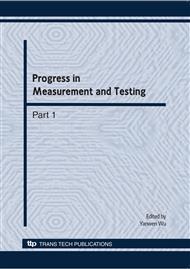[1]
SUN Jun-hua, WEI Zhen-zhong, ZHANG Guang-jun. A coding method for high-density grating structured light [J]. Opto-Electronic Engineering, 2006, 33(7): 78~82.
Google Scholar
[2]
ZHANG Yongjun, ZHANG Zuxun, ZHANG Jianqing, Camera calibration Using 2D_DLT and Bundle Adjustment with Planar Scenes[J]. Geometrics and Information Science of Wuhan University, 2002, 6(27), 566~571.
Google Scholar
[3]
ZHANG Zuxun, SU Guozhong ZHENG Shunyi, ZHANG Jianqing, Relation OpenGL Imaging Process with Exterior and Interior Parameters of Photogrammetry[J]. Geometrics and Information Science of Wuhan University, 2004, 7(29), 570~574.
Google Scholar
[4]
YIN Li-ping, YU Xiao-yang, WU Hai-bin, The Development of 3D Measurement Technology Based on Structured Light by Combining Gray Code with Phase-shift [J]. JOURNAL HARBING UNIV. SCI. &TECH, 2007, 5 (12), 5~7, 11.
Google Scholar
[5]
Li, Hao; Straub, Raphael; Prautzsch, Hartmut. Structured light based reconstruction under local spatial coherence assumption[C]. 3rd International Symposium on 3D Data Processing, Visualization, and Transmission, 3DPVT (2006).
DOI: 10.1109/3dpvt.2006.132
Google Scholar
[6]
Yang, Rongqian Cheng, Sheng Yang, Wei Chen, Yazhu. Robust and accurate surface measurement using structured light[J]. IEEE Transactions on Instrumentation and Measurement, June (2008).
DOI: 10.1109/tim.2007.915103
Google Scholar
[7]
Wei, Zhenzhong; Zhou, Fuqiang; Zhang, Guangjun. 3D coordinates measurement based on structured light sensor [J]. Sensors and Actuators, A: Physical. May 17 (2005).
DOI: 10.1016/j.sna.2004.12.007
Google Scholar
[8]
LI Hong-yan, A Method of Threshold Segmentation Based on Special Binary Code [J]. Computer Imitate,2008, (07): 196~199.
Google Scholar
[9]
YUE Huimin . Research on three-dimensional profilometry based on temporal phase unwrapping.
Google Scholar
[10]
ZHANG Zuxun, ZHANG Jianqing. Digital Photogrammetry Science [M]. Wuhan University, (2001).
Google Scholar
[11]
CHENG Junting, ZHAO Can, MO Jian hua, Free-form 3-D Profilometry Based on Coding Structured Light and Epipolar Constraint[J]. Computer Measurement & Control, (2007).
Google Scholar
[12]
Alda S, Cremers A B. Towards composition management for component-based peer-to-peer architectures [J]. Electronic Notes in Theoretical Computer Science, 2005(114): 47~64.
DOI: 10.1016/j.entcs.2004.02.067
Google Scholar
[13]
Klette R, Schluns K, Koschan A. Computer vision: three dimensional data from images. Germany: SpringerPress, (1998).
Google Scholar
[14]
Chen Rui-gai ChenHuai-xin. A new method for interference fringe skeletonzing and thinning [J]. Laser Journal, 2005, 26(5): 40~41.
Google Scholar


